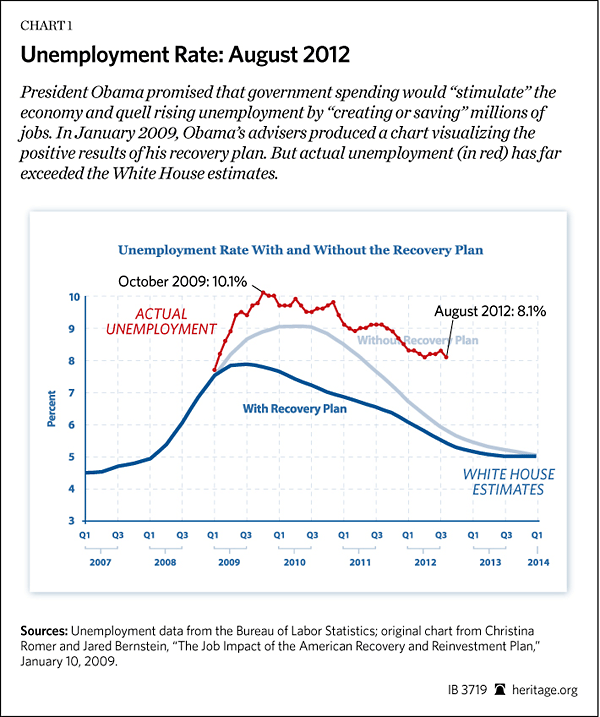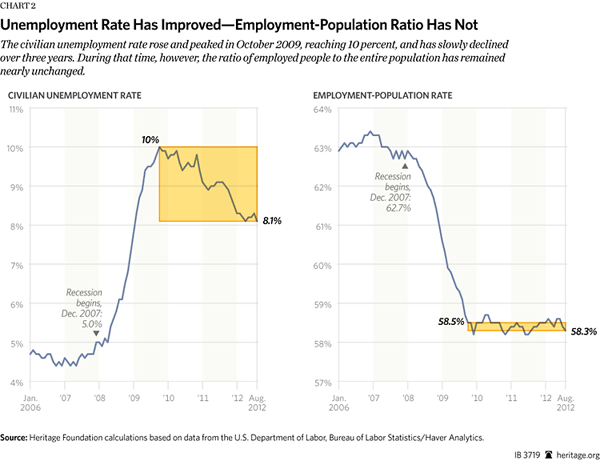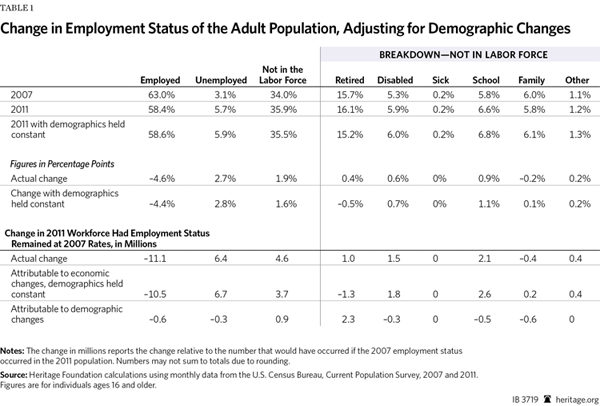The Bureau of Labor Statistics reported that the economy created on net 96,000 new jobs in August and that the unemployment rate fell to 8.1 percent. The decline in the unemployment rate was entirely due to a steep decline in the percentage of people in the labor force, which reached a 30-year low.
Forward-looking indicators tell a grim story as the labor market continues to struggle and revisions to the previous jobs reports for June and July reduced job growth by over 40,000 jobs total. The next few months will offer little relief to the unemployed, as many businesses are already cutting back in anticipation of Taxmageddon.
The August Report: Fall in Labor Force Paricipation
The household report indicated that the labor force participation rate declined to 63.5 percent, the lowest level in over three decades. Almost 400,000 potential workers exited the labor force, and this explained why the unemployment rate fell from 8.3 percent to 8.1 percent. In August, the participation rate of adult men in the labor force fell to an all-time low. While the number of men in the labor force has been trending down, their participation rate was expected to climb as the economy recovered. Instead, the participation rate has continued to fall even as the economy began expanding.

For long-term unemployed workers, their situation worsened in August, with the average duration of unemployment climbing back over 39 weeks and the median duration of unemployment climbing to 18 weeks. The good news is that this figure is still lower than the one from the same time last year: In August 2011, the average duration of unemployment was over 40 weeks. However, this is very slow progress given the magnitude of the recession.
The payroll survey contained even worse news. Private-sector job growth was 103,000, while the government workforce declined by 7,000 workers. Manufacturing jobs (–15,000) declined, as did temporary help services (–4,900). Temporary help is usually an omen for future job growth, so this decline indicates that future labor market growth will be slow. Revisions to the June and July employment reports were also negative, reducing job growth by a total of over 40,000 jobs.
Hours of work were flat, but the number on wages is alarming: Hourly wages actually declined in August. This indicates that the slack in the labor market is increasing, which again means that the prospects for robust future job gains are bleak.
Smaller Labor Force
The labor market is much weaker than the headline unemployment rate suggests. Since the recession ended, job growth has only kept pace with population growth. The share of the adult population with jobs has remained flat for the past two years. Unemployment has fallen because fewer Americans are looking for work.
The labor force participation rate—the proportion of Americans either working or job searching—has fallen by 2.5 percentage points between December 2007 and August 2012. The drop in August is part of a longer trend. If the participation rate had remained at pre-recession levels, over 4.6 million more Americans would either have jobs or be looking for them.[1]
Demographic factors explain about one-fifth of the drop in labor force participation: The baby boom generation has begun retiring. An older population has more retirees and fewer workers irrespective of the state of the economy.[2] The economy’s weakness has caused the remaining four-fifths of the decrease.
School and Disability Benefits
The workers now outside the labor force are primarily either studying in school or collecting disability benefits. Approximately 2.1 million more Americans report being outside the labor force and enrolled in school. The weak economy has both made it more difficult for students to find part-time jobs and reduced the opportunity cost of going to school. One of the major costs of studying is forgoing income from a full-time job. The difficulty of finding work has made studying relatively more attractive. Both of these factors—the difficulty of finding work and the increased attractiveness of school—have increased the number of Americans studying and outside the labor force.
The number of Americans collecting disability benefits has also grown notably in the recession. Almost 6 percent of the adult population reports being disabled and outside the labor force—an increase of 1.5 million people since 2007.[3]
Americans have not become sicker over the past four years; medical technology has only gotten better. Instead, studies show that a significant number of workers who apply for disability benefits are not entirely disabled. They have medical conditions that qualify them for benefits, but under other circumstances they could work at some type of job. Given the option of receiving benefits, however, they take them.[4] The effect is particularly pronounced for lower-income workers, who are much more likely to be affected by the difficult job market.
Long-Term Consequences
While the vast majority of students will return to the labor force, few starting on disability insurance will ever work again. Congress created the “Ticket-to-Work” program in 1999, which allowed Social Security Disability Insurance (SSDI) beneficiaries to return to work while keeping their health coverage. Over the next seven years, fewer than 1,400 claimants used the program to return to work.[5]
The drop in labor force participation will do long-term economic damage. Fewer employees will be responsible for working to sustain an increasing number of people outside the labor force. This will lead to either higher taxes or lower benefits, resulting in lower standards of living for all Americans. Congress will have to address this problem soon. The Social Security trustees project that the SSDI trust fund will run out by 2016.[6]
A Non-Recovery Recovery
The August report shows that the labor market is continuing its non-recovery. Average job growth for 2012 is worse than average job growth in 2011. The labor market should simply be stronger at this point in the recovery than it is right now. Instead, several indicators are not recovering at all or even continuing to decline.
Fiscal policies from Washington have made the situation worse. While President Obama has promised to reduce regulations, which would help job creation, his largest initiative—Obamacare—will harm employment. The Obamacare tax hikes coincide with the expiration of the 2001 and 2003 tax cuts in January 2013. This will throw the economy into another deep recession, and businesses are already delaying investment and hiring as a result.
Rea S. Hederman Jr.is Assistant Director and Research Fellow, and James Sherk is Senior Policy Analyst in Labor Economics, in the Center for Data Analysis at The Heritage Foundation.




